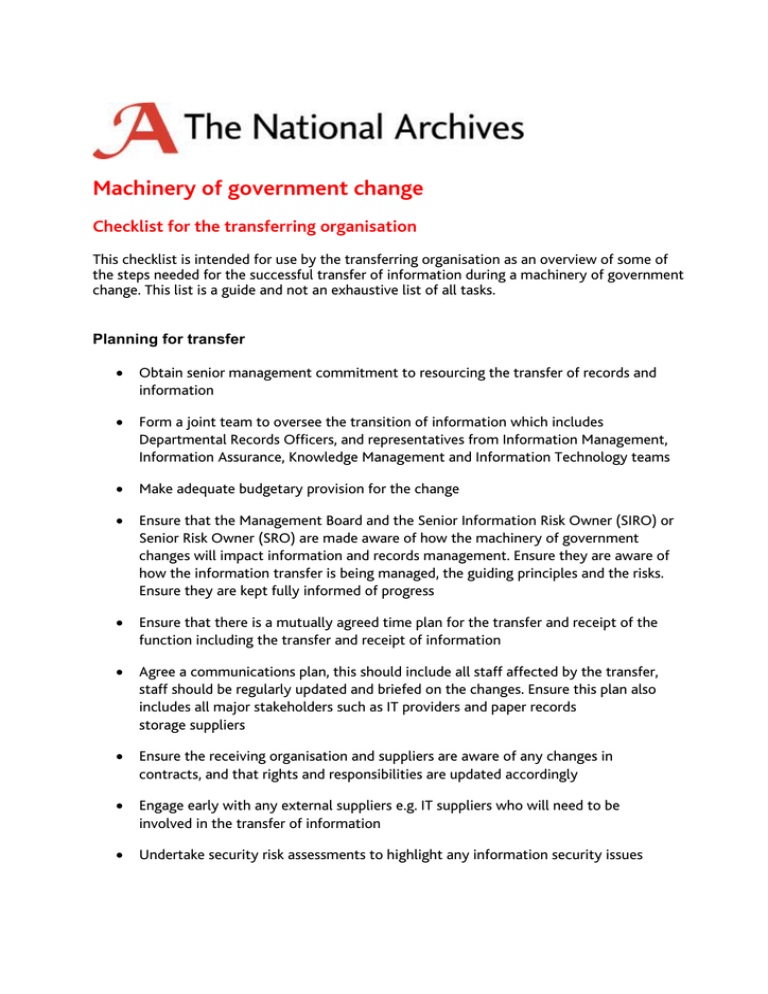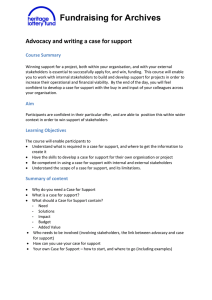Machinery of government change Checklist for the transferring organisation
advertisement

Machinery of government change Checklist for the transferring organisation This checklist is intended for use by the transferring organisation as an overview of some of the steps needed for the successful transfer of information during a machinery of government change. This list is a guide and not an exhaustive list of all tasks. Planning for transfer • Obtain senior management commitment to resourcing the transfer of records and information • Form a joint team to oversee the transition of information which includes Departmental Records Officers, and representatives from Information Management, Information Assurance, Knowledge Management and Information Technology teams • Make adequate budgetary provision for the change • Ensure that the Management Board and the Senior Information Risk Owner (SIRO) or Senior Risk Owner (SRO) are made aware of how the machinery of government changes will impact information and records management. Ensure they are aware of how the information transfer is being managed, the guiding principles and the risks. Ensure they are kept fully informed of progress • Ensure that there is a mutually agreed time plan for the transfer and receipt of the function including the transfer and receipt of information • Agree a communications plan, this should include all staff affected by the transfer, staff should be regularly updated and briefed on the changes. Ensure this plan also includes all major stakeholders such as IT providers and paper records storage suppliers • Ensure the receiving organisation and suppliers are aware of any changes in contracts, and that rights and responsibilities are updated accordingly • Engage early with any external suppliers e.g. IT suppliers who will need to be involved in the transfer of information • Undertake security risk assessments to highlight any information security issues Identify information for transfer • Identify information (regardless of form and formats) that will need to be transferred. This may include paper records, emails, databases, folders, files, systems, websites and library collections • Agree what records and information will be transferred to the receiving organisation and in what format and by what means. Compile a list of all records being transferred and agree this with the receiving organisation. Document these records on the Transfer Agreement • Identify any informal knowledge that needs to be captured and transferred and by what method this information can be captured e.g. handover notes, transfer questionnaires and exit interviews with staff • Identify information about both the paper and digital records to be transferred e.g. prefix bibles, information about file series, zero files, docket books and card indexes as well as retention and disposal information relating to the records of the function • Identify information relating to databases, printed guidance or manuals relevant to the function or relating to databases • Identify information about any systems or information being transferred, such as contracts and file structures • Ensure the transferring and receiving organisations are aware of where all web content is published including all non Gov.uk presence such as Tumblr and social media e.g. Twitter and YouTube Security and legislation considerations • Liaise with the receiving organisation as to what classified material should be transferred, and if the receiving organisation will need to upgrade information security • Identify any FOI/DP/EIR legislation affecting the information transfer and ensure that the receiving organisation is notified • Identify any ongoing FOI/DP/EIR enquiries or complaints and ensure that relevant customers (including members of the public, ICO, Information Tribunal) are aware of the changes and any potential delays due to the changes • Identify any live Parliamentary Questions (PQs). Ensure that the responsible areas within the receiving organisation are briefed on past and expected future PQs • Manage and respond to any live/new FOI/DP/EIR or Parliamentary Questions with the relevant area within the receiving organisation. Pass over any outstanding request, complaint, review or appeal to the receiving organisation after the change has been completed • Identify all digital information including social media such as facebook, twitter and Tumblr as well as all websites. Ensure that websites have been captured on the UK Government Web Archive – contact the web archiving team at The National Archives for further information Transfer information securely • Ensure government data handling and information security procedures are maintained throughout the transferring and receiving of all information and records • Ensure the receiving organisation is aware of records already transferred to holdings at The National Archives • Ensure the transfer form is completed and agreed before any information is deleted or disposed of Following transfer of information • Ensure that customers are redirected from the websites external to GOV.UK • Update staff directories and intranets • Update all asset registers, information risk registers, disaster plans and business continuity plans







